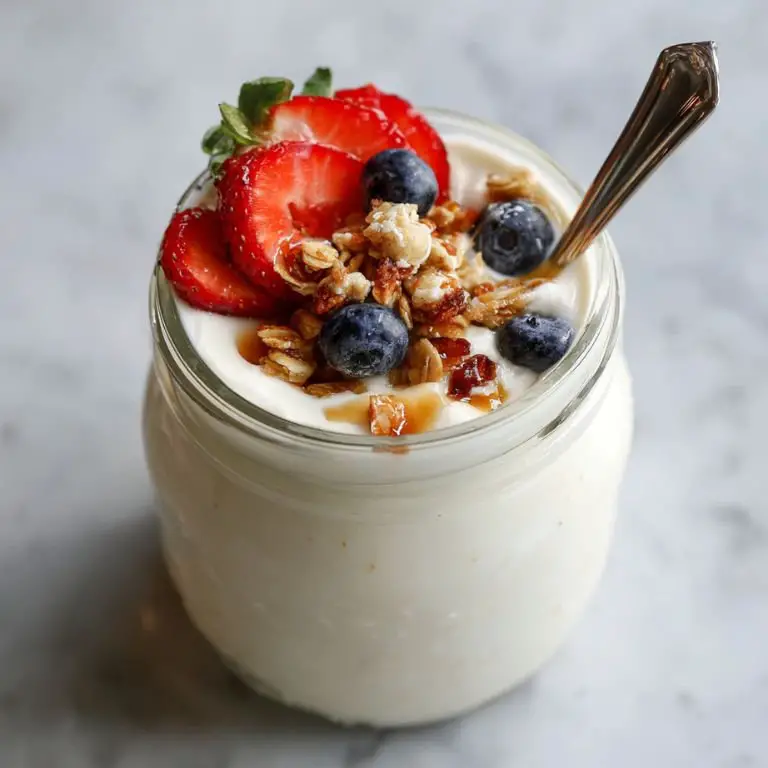There’s something truly satisfying about making your own yogurt at home, especially when it’s vegan, silky-smooth, and bursting with tropical coconut flavor. This homemade vegan yogurt with coconut milk and agar is a game changer—rich, slightly tangy, and naturally dairy-free. Whether you're building the perfect yoghurt bowl or spooning it into a yoghurt dessert, this easy plant-based yogurt recipe will become a staple in your kitchen. With just a few ingredients and some patience, you’ll have a batch of creamy goodness that works beautifully for everything from a vegan breakfast healthy option to baking yoghurt bread.
Creamy Homemade Vegan Yogurt with Coconut Milk and Agar
Prep Time 10 minutes mins
Cook Time 10 minutes mins
Incubation Time 10 hours hrs
Total Time 10 hours hrs 20 minutes mins
Course Breakfast, Condiment, Dessert, Snack
Cuisine Indian, Mediterranean, Middle Eastern, Vegan
Medium saucepan To gently heat and dissolve the agar in coconut milk.
Whisk Ensures the agar is well incorporated without clumps.
Thermometer Optional but recommended. Helps monitor cooling before adding cultures (ideal range is around 105°F).
Glass jar(s) with lid For incubating the yogurt. Mason jars work great.
Warm spot or yogurt maker You can use a yogurt maker, Instant Pot with a yogurt setting, or simply a warm oven (turned off but with the light on). A heating pad also works.
Cheesecloth or paper towel and rubber band (if fermenting uncovered) Allows air circulation while keeping dust out.
- 2 cans 13.5 oz each full-fat coconut milk – Choose a brand with minimal additives. The full fat is crucial for that thick, creamy consistency.
- 1½ teaspoons agar agar powder – This acts as the thickener. Don’t substitute with gelatin if you're keeping it vegan.
- 2 teaspoons maple syrup or agave syrup – A bit of sweetness helps activate the cultures and enhances the flavor.
- 1 to 2 tablespoons vegan yogurt starter – You can use store-bought unsweetened vegan yogurt with live cultures or powdered starter designed for plant based yogurt recipe use.
- Optional: ½ teaspoon vanilla extract for added flavor.
Heat the Coconut Milk
In a medium saucepan over medium heat, pour in both cans of full-fat coconut milk. Whisk in the agar agar powder evenly to avoid clumps. Bring the mixture to a gentle simmer, stirring continuously.
Once it starts bubbling, let it simmer for 3 to 5 minutes. This activates the agar and ensures the mixture thickens properly. Don’t let it boil too aggressively or it may alter the flavor.
Sweeten and Cool
Turn off the heat and stir in the maple syrup (and vanilla extract if using). Let the mixture cool to about 105°F (40°C). This is important—too hot and it will kill the live cultures.
Add the Vegan Yogurt Starter
Once cooled, add your vegan yogurt starter or a few spoonfuls of unsweetened store-bought vegan yoghurt with live cultures. Stir gently to combine.
Incubate the Yogurt
Pour the mixture into a clean glass jar or jars. Cover loosely with a lid or a piece of cheesecloth secured with a rubber band.
Place the jar in a warm, draft-free area where it can maintain a temperature of 100–110°F. This could be a yogurt maker, an Instant Pot on the yogurt setting, or a warm oven with just the light on.
Let it incubate for at least 8–10 hours. The longer it sits, the tangier it becomes. Taste at the 10-hour mark and let it go longer if you like a more pronounced tartness.
Chill and Thicken
Once fermented, stir the yogurt gently (it may look a little separated; that’s normal) and refrigerate it for at least 4 hours. It will thicken further as it chills.
Before serving, give it another gentle stir for an even texture.
Serving Suggestions and Pairings
This dairy free yogurt recipe is incredibly versatile. Here are a few creative ways to enjoy it:
1. Yoghurt Bowl Ideas
Top with fresh berries, sliced banana, hemp seeds, and a drizzle of almond butter for a vegan breakfast healthy treat that keeps you full and energized.
2. Yoghurt Dessert
Layer your coconut yogurt with crushed vegan cookies, chopped fruit, and a touch of maple syrup for a quick, tangy dessert. Add a sprinkle of cinnamon or toasted coconut for flair.
3. Savory Twist
Mix with garlic, lemon juice, and herbs to make a dairy-free dip for roasted veggies or flatbread. It's a cool counterpoint to spicy dishes.
4. In Baking
Use it in plain yogurt recipes like muffins, cakes, or even yoghurt bread. Its thickness adds moisture and tang, much like traditional yogurt.
5. Smoothie Base
Blend it with frozen mango, a splash of orange juice, and turmeric for a vibrant, tropical smoothie with probiotic power.
FAQs
1. Can I use light coconut milk instead of full-fat?
You can, but the consistency will be much thinner and less creamy. For best results, always go with full-fat coconut milk.
2. What type of yogurt starter is best?
A plain, unsweetened vegan yogurt with live cultures works well. You can also buy a powdered vegan yogurt starter designed for plant-based fermenting.
3. How long does homemade vegan yogurt last?
Stored in a sealed container in the fridge, it will last about 5 to 7 days. Always check for off smells or mold.
4. Can I flavor the yogurt before fermenting?
Stick to plain for fermentation. Add flavors like vanilla, fruit, or spices after the yogurt has set and chilled to avoid interfering with the cultures.
5. Is agar agar the only thickener I can use?
Agar is ideal for a vegan yoghurt recipe because it's plant-based. If you're okay experimenting, tapioca starch or arrowroot might work, but results can vary in texture.
